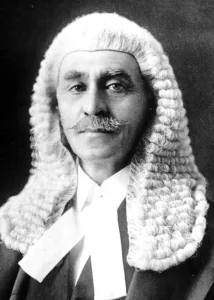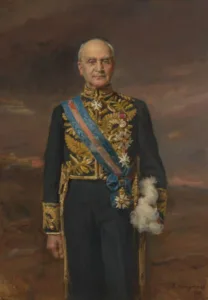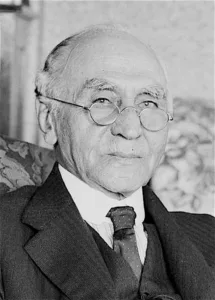From Australia’s Jewish Past:
Sir Isaac Alfred Isaacs GCB GCMG PC KC
The First Jewish AND AUSTRALIAN BORN Governor-General of Australia - 1931-1936
First published in J-Wire January 24, 2023

Isaac Isaacs was born on August 6, 1855, in Melbourne, the son of Alfred and Rebecca Isaacs.
Alfred, a tailor from the town of Mława, Poland, left home to seek better prospects. He worked his way across Europe and arrived in London in 1845, where he met and married Rebecca Abrahams in 1849.
Following the news of the 1851 Victorian Gold Rush, Australia became a very popular destination, and Alfred and Rebecca left for Melbourne in 1854, arriving in September of that year. Alfred was fortunate to build his tailoring business in a shopfront in Elizabeth Street. The family moved to various locations around Melbourne and in 1859 moved to the gold-mining town of Yackandandah in northern Victoria.
Isaac, the eldest of six children, started school in 1860 at a small private establishment, then moved on to Yackandandah State School when it opened in 1863. He excelled academically, particularly in arithmetic and language, although he frequently truanted school to spend time in the nearby mining camps. In 1867, the family moved to Beechworth so that he could have a better quality of education. He attended the Beechworth Grammar School.
Isaac excelled at school and became dux in his first year, winning many academic prizes. He was fluent in languages speaking Russian, Italian, French, Greek, Hindustani, Chinese and some German. In his second year at Beechworth, he was employed part-time as an assistant teacher and tutored some of his fellow students. In September 1870, when Isaac was only fifteen years old, he passed his examination as a pupil teacher and continued to teach at Beechworth Grammar until 1873 before moving on to teach at Beechworth State School. Whilst there, he had his first experience of the law as an unsuccessful litigant in an 1875 county court case. He disputed a payment arrangement with the headmaster of his school, resigning as part of the dispute. On returning to teach at Beechworth Grammar School, he expanded his interest in the law moving to Melbourne in 1875 to work as a clerk, studying law part-time at the University of Melbourne.

He was admitted to the Bar in 1880 becoming a Queen’s Counsel in 1899. He became one of Melbourne’s best-known barristers. In 1888 Isaacs married Deborah (Daisy) Jacobs in Melbourne. They had two daughters, Marjorie (b 1889) and Nancy (b 1892).
In 1892 he was elected to the Victorian Legislative Assembly and subsequently served as Solicitor-General and Attorney-General.
Records of the Australasian Federal Conventions of the 1890s, state:- there had been many debates taking place through the 1890s with regard to the possibility of Australia becoming a Federation. The Premiers of New South Wales, Victoria, South Australia and Tasmania agreed that the enabling acts were finally to come into force and the writs for the election of candidates to a Federal Convention would be issued on Foundation Day, 26 January 1897, with elections to be held between 4 and 6 March for the four states – Queensland and West Australia chose not to be included. The direct involvement of people in voting for delegates to represent them at a Federal Convention was a chance to rekindle an interest in Federation and to arouse a genuine enthusiasm for the cause. The election campaign would provide an opportunity to further guide, educate and shape public opinion and would also encourage candidates to look closely at the proposed Federation and a Federal Constitution. Isaac was elected to this Convention to approve the terms of the Australian Constitution.
However, Isaac was not elected to the committee to draft the Constitution. Prime Minister Alfred Deakin attributed this failure to “a plot discreditable to all engaged in it” and thought that this antagonising and humiliating snub sharpened Isaacs’s “tendency to minute technical criticism … so as to bring him not infrequently into collision” with the committee. Isaacs had many reservations about the draft constitution, but he campaigned in support of it after the Australian Natives’ Association gave the draft its full support, rejecting his plea to delay for further consideration. Isaac was elected to the first Federal Parliament in 1901 to the seat of Indi as a critical supporter of Edmund Barton and his Protectionist Government (Australian Liberal political party advocating protective tariffs, arguing it would allow Australian industry to grow and provide employment.) He was one of a group of backbenchers pushing for more radical policies, and he earned the dislike of many of his colleagues through what they saw as his aloofness and a rather self-righteous attitude to politics.
Alfred Deakin appointed Isaac Attorney-General in 1905, but he was a difficult colleague. In 1906 the Prime Minister was keen to have him out of politics and appointed him a Justice of the High Court.
Isaacs was often in the minority in his early years on the Bench, particularly concerning federalism, where he advocated the supremacy of the Commonwealth Government. He served on the Bench for twenty- four years, acquiring a reputation as a learned and radical. He was the first serving minister to resign from the parliament. Isaac was appointed a Knight Commander of the Order of St Michael and St George in the King’s Birthday Honours of 1928 for his service on the High Court. He is one of only eight justices of the High Court to have served in the Parliament of Australia before his appointment to the Court.
In 1931, Prime Minister James Scullin appointed Isaacs to the position of Chief Justice and, later that year nominated him as his preferred choice for Governor-General. The selection of an Australian, rather than the usual British appointee, was unprecedented and highly controversial. Interestingly, King George V was opposed to the idea as he thought the choice would be “a very unpopular one’’. He eventually consented and Sir Isaac Issacs took office on 22 January 1931 as the first Australian-born holder of the office. In view of all the controversy, Sir Isaac agreed to a reduction in salary and conducted the office with great frugality. He was the first Governor-General to reside full-time at Government House in Canberra and, throughout his five-year term, was most popular amongst the public for his frugality during the Depression. Sir Isaac was promoted to a Knight Grand Cross of the Order of St Michael and St George in April 1932.

His term of office concluded on 23 January 1936 when he was eighty-one and he retired to Victoria the following year. However, his public life was far from over. He remained active in various causes for a further ten years and wrote frequently on matters of constitutional law. He was further honoured with the award of Knight Grand Cross of the Order of the Bath.
In May 1949, he was honoured with the naming of the Australian Electoral Division of Isaacs in the outer southern suburbs of Melbourne. At a redistribution in November 1968, a separate division of Isaacs was created in the south-eastern suburbs of Melbourne and exists today. The Canberra suburb of Isaacs was named after him in 1966. In 1973 Isaacs was honoured with an Australian postage stamp bearing his portrait.

As well as the first Australian-born Governor-General, he was the first Jewish High Court Justice and the first Jewish Chief Justice. He was a strong anti-Zionist, opposing Zionism partly because he disliked nationalism of all kinds and saw Zionism as a form of Jewish national chauvinism and partly because he saw the Zionist agitation in Palestine as disloyal to the British Empire to which he was devoted.
Sir Isaac Alfred Isaacs passed away on February 11, 1948, in Melbourne. Lady Deborah Isaacs died in Bowral in 1960.
Acknowledgments
- Australian Dictionary of Biography (Sir Zelman Cowen);
- Wikipedia;
- Canberra Law Review;
- Parliament of Australia;
- Victorian Government Archives;
- High Court of Australia;
- National Library of Australia.
